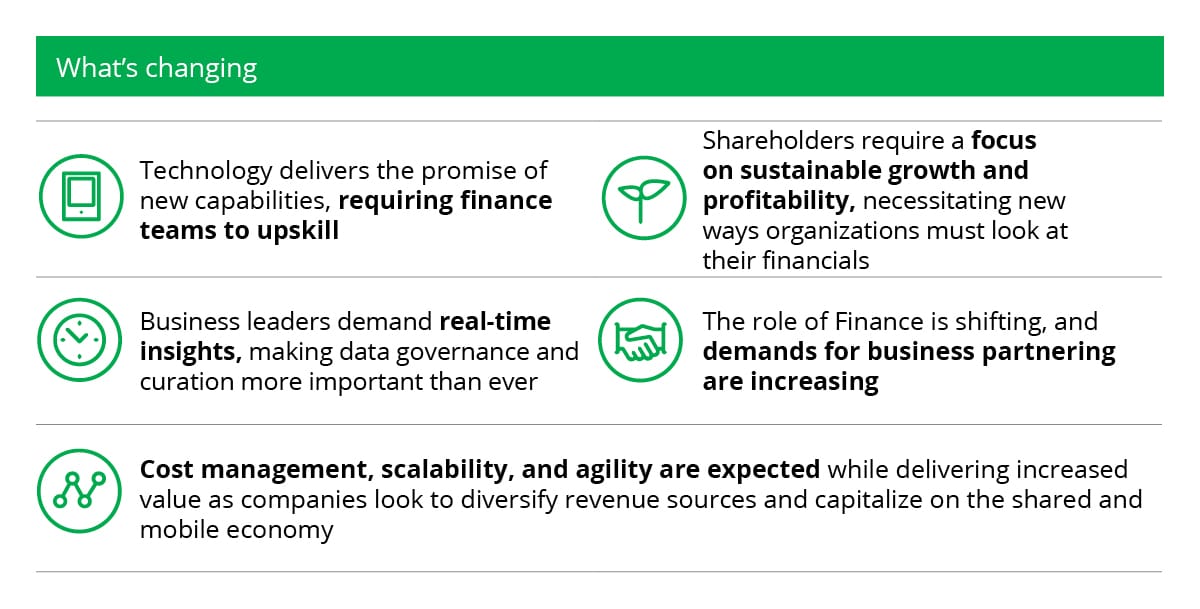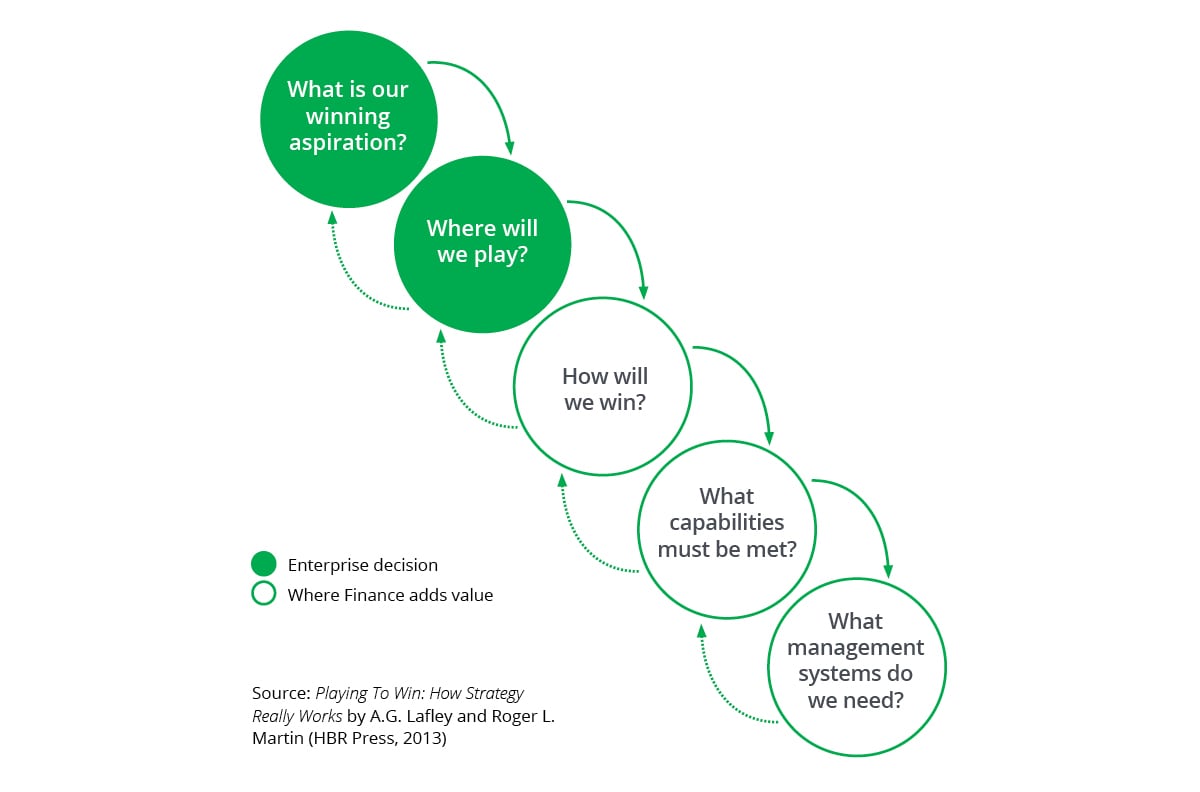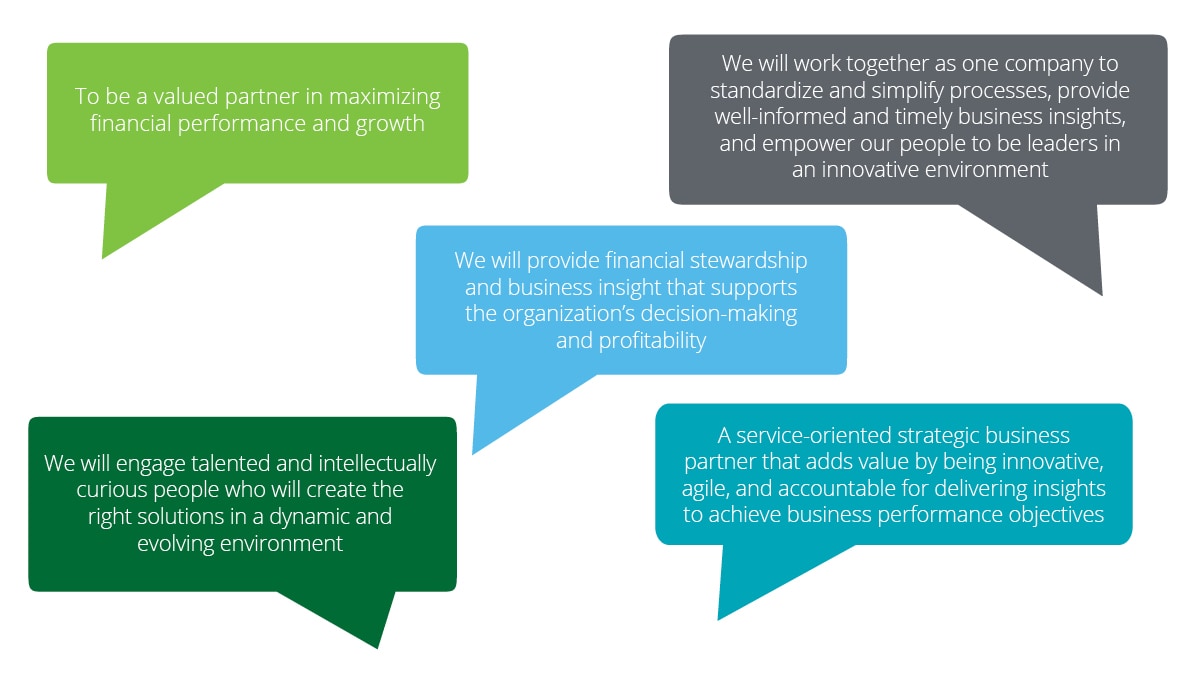Perspectives

ERP transformation vision and road map for the finance function
Get started on the right path
ERP-enabled finance transformation can elevate the strategic value of the finance function. But how you define the journey is key. Discover how to develop a finance transformation vision and road map that can help the finance function deliver greater impact for your business.
Explore Content
- Getting your ERP-enabled finance transformation on the right path
- Keeping up with a changing landscape
- Elements of an ERP-enabled finance transformation strategy
- Ready to get started? Key activities and considerations
- Your next move
Getting your ERP-enabled finance transformation on the right path
Like many finance leaders today, you may be thinking about how digital transformation might enable new finance capabilities and drive better business insights. At the same time, COVID-19 may be prompting your IT organization to consider new enterprise resource planning (ERP) systems that can simplify system architecture, reduce costs, and make current infrastructure easier to manage and more agile.
If your organization has already completed a remote close process, you have also likely identified the need for increased standardization and access to data in a remote work environment, for both business continuity and delivery of business insights. For many organizations, addressing these new and evolving challenges will start with a finance vision and road map to inform an ERP-enabled finance transformation journey. What should be top of mind, and where do you begin?
Keeping up with a changing landscape
With many businesses undergoing rapid change, executives are looking to Finance and enabling technology to help deliver business insights, automate decision support, and drive advanced capabilities. The changing landscape is positioning the finance function to serve as a more effective and efficient business partner.
Change imperatives for the finance function

Elements of an ERP-enabled finance transformation strategy
Chances are, your finance team is routinely pulled in multiple directions, each with competing needs and stakeholders. Particularly in this context, an ERP-enabled finance transformation journey requires a clearly defined and communicated strategy, beginning with both a vision and a road map. These serve as strategic guides for modernizing and transforming capabilities.
Define the finance vision
The finance vision is a set of choices and goals that articulate and align Finance’s aspirations for how the function serves and partners with the organization. The vision becomes the “North Star” for the ERP-enabled finance transformation.
To create the finance vision, start with your organization’s strategy and the role Finance will play in enabling key business decisions. Focus on how you will generate insight and value for the business based on the company’s business strategy. Answering the questions in the Strategic Choice Cascade below provides a good starting point for articulating your vision.

Answering these questions will help your finance organization determine how to deliver value to your stakeholders. For example, a consumer product company focused on managing operating expenses may want to invest more heavily in standardizing and automating processes via robotic process automation. Alternatively, a technology company interested in expanding into new markets may want to invest more heavily in financial planning and analysis and predictive analytics capabilities to assess market growth potential.
Once priorities are aligned to the business strategy, define your goals and aspirations by answering the following questions:
- Where does the company expect to win in the market, and how will Finance support the business?
- What value should Finance deliver to the business? How can the finance team enable new capabilities that can evolve with new business models, analytics needs, and acquisitions?
- Do all business-critical stakeholders have a seat at the table? Is there cross-functional leadership alignment (e.g., Finance, IT, supply chain, business units) with regard to the capabilities and functionality required to enable the business strategy?
- How will Finance support value creation and growth while managing expenses?
- Since transformation (and related ERP and edge solution implementations) take place over several years, how will the finance organization create momentum and sustain it throughout the project? How will the organization manage change and enable the future workforce to deliver on promised capabilities?
Warning signs: Strategy of symptom-solving
As you embark on transformation, make a clear distinction between the vision you want to achieve and potential solutions such as:
- Developing functional strategies related to finance (e.g., tax and treasury)
- Implementing an ERP system
- Performing a benchmarking assessment
- Executing process reengineering initiatives
- Identifying and implementing point solutions
Most road maps will naturally include these solutions; this is appropriate and can be beneficial but should not distract from the bigger transformation picture.
The organization’s vision guides the finance transformation journey and helps prioritize its digital systems, tools, processes, organization, and data decisions.
Sample vision statements:

Build a prioritized road map
The finance transformation road map is a practical articulation of the vision—a prioritized, aligned, and sequenced list of initiatives that addresses people, process, and technology enablers. The following steps are required to build the road map:
- Partner with IT, procurement, supply chain, commercial, and other key stakeholders to assess current-state capabilities, tools, and the desired future state.
- Identify required initiatives across the people, process, and technology pillars to achieve the finance vision for future-state capabilities.
- Evaluate the role of ERP and other systems and tools in enabling the finance transformation.
- Finalize a list of key initiatives and ongoing or competing priorities; for each initiative, identify resources, milestones, timing, dependencies, and risks.
The initiatives should be tailored to each organization’s finance vision, resource capacity, priorities, and maturity of its current capabilities. The finance vision acts as a guide to prioritize initiatives. For example, some organizations may prioritize innovative capabilities, automated controls, and employee experience ahead of cost and efficiency, while others may prioritize cost and efficiency above all else.
Ultimately, a well-drawn-out road map will showcase a few different aspects (download the PDF to see an illustrative road map):
- Three to five years of prioritized initiatives: Road maps should include a three-to-five-year time horizon and enable value realization across the defined time horizon, not just at the end.
- Key milestones: Milestones should be defined to measure progress against initiatives and link interdependencies across the road map.
- Initiatives grouped by type: Initiatives should be grouped by type, with key interdependencies defined across people and organization, process, technology, and data.
- Program governance: Program governance touchpoints with the steering committee and other key leaders should be scheduled, with required decisions and topics defined.
- “Other” ongoing initiatives: Other key initiatives affecting stakeholders and resources, or that have interdependencies, should be included on the road map.
Transformation requires significant dedication and knowledge—often from a set of high-potential or highly knowledgeable talent. The road map helps the finance organization plan how to juggle competing demands and answer some critical questions:
- Value: How does Finance maintain momentum and achieve wins during a multiyear, ERP-enabled transformation (e.g., quick wins and pilots)?
- Process: What level of process redesign and standardization is required prior to implementing the new ERP?
- Technology: What is the data strategy, including the corresponding data requirements to enable the desired reporting capabilities?
- People: How will current employees need to be retooled so that they can effectively partner with the business in a digitally enabled finance organization? Where is the work delivered now, and where will it, or could it, be delivered?
Ready to get started? Key activities and considerations
Setting off on your ERP-enabled finance transformation means understanding what technology can achieve for your organization. Gathering input from stakeholders and maintaining alignment with the rest of the enterprise are essential.
Getting started with the finance transformation

Transformation is an opportunity to change everything. As your organization defines the “North Star” that will guide your transformation and builds the integrated road map to enable the vision and generate value for stakeholders, consider these guidelines for success:
- Build from the business vision and strategy. For instance, if the business plans significant M&A activity, expansion to a new geography, or a new way of managing customers (requiring new levels of detail), then Finance should craft its strategy to support these objectives.
- Engage key business stakeholders and IT from the beginning. IT should provide direction on the future-state enterprise data strategy and enterprise system and application architecture to ensure alignment and help guide road map development.
- Aim high, but be realistic. Include reasonably achievable opportunities as part of the vision and faster wins early in the road map to build buy-in.
- Be inclusive within Finance. Transformation affects all of Finance. Operating as one finance team can reveal opportunities and challenges that might be missed by a less representative team.
- Define reporting strategy early. Understanding what information and supporting data the business needs can be critical to realizing the new capabilities enabled by ERP and digital tools.
- Build and manage to key metrics. Defining metrics that capture the transformation’s value is critical to achieving the vision. Having a measurable way of showing the impact of the transformation makes the value real early on.
- Integrate ERP with operating model transformation. Defining what will be delivered where and with what tools will shape decisions about the number of instances, what data to pull in, and how many variations and customizations are allowable in the future.
